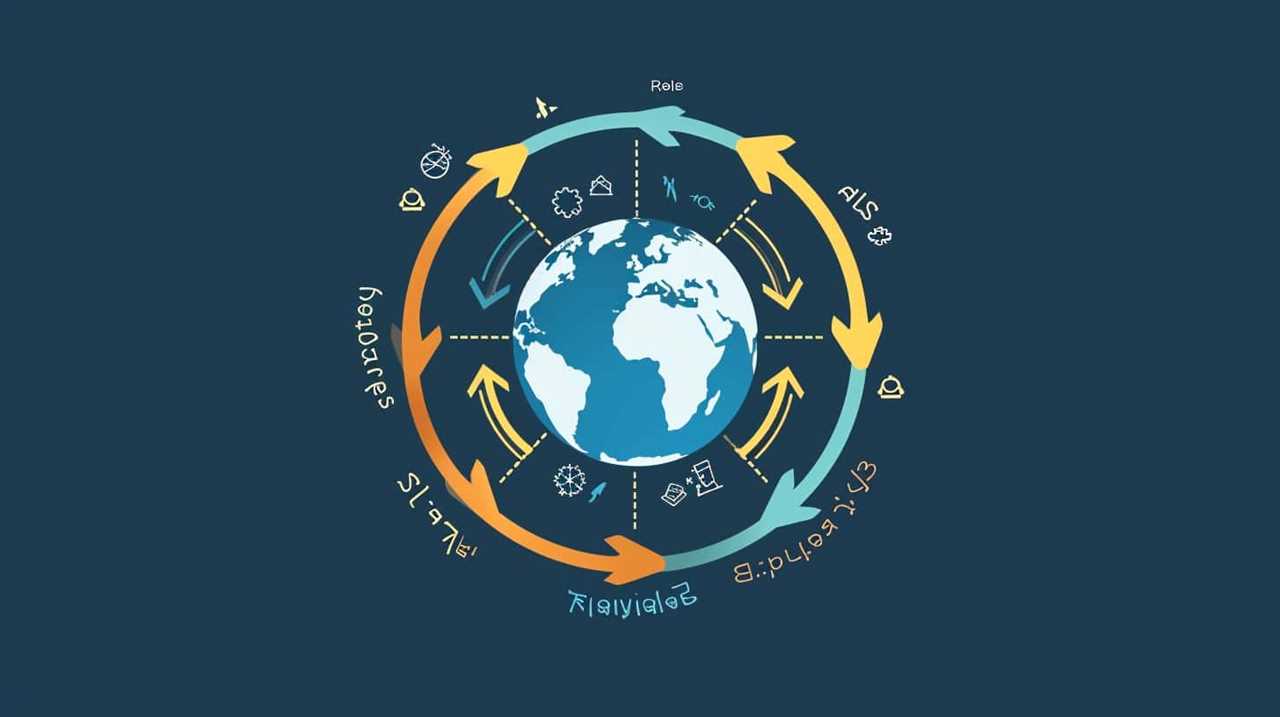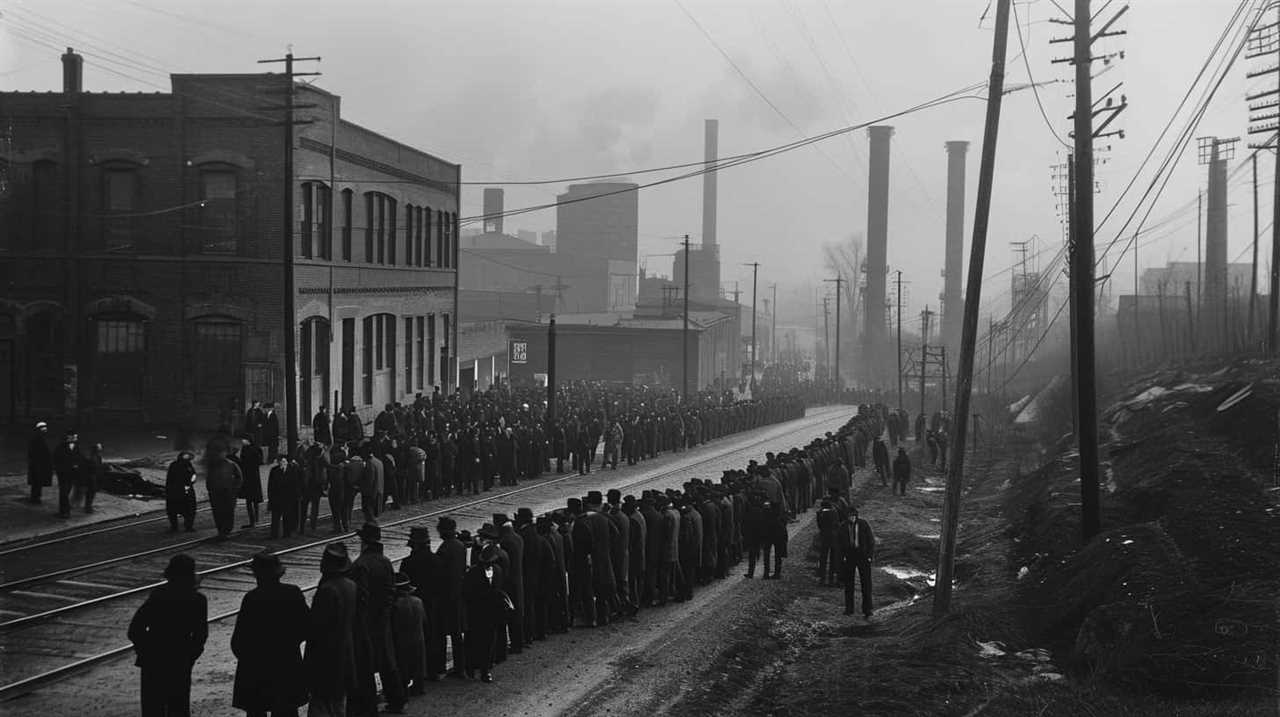Are you doubtful about the efficiency of fiscal policy in promoting economic growth and stability? Allow us to acquaint you with the principles of Keynesian economics!
In this short guide, we will explore the principles of fiscal policy through the lens of Keynesian logic. By understanding the basics of Keynesian economics, we can grasp how government intervention and the manipulation of aggregate demand can stimulate economic activity.
We will delve into the concept of the multiplier effect, the role of countercyclical policies, and the importance of public investment. However, we will also address the limitations and criticisms of Keynesian economics, providing a balanced perspective for those seeking innovative approaches to economic policymaking.
So, let’s dive in and unlock the potential of fiscal policy through the lens of Keynesian logic!

Key Takeaways
- Keynesian economics emphasizes the role of government spending in stimulating economic growth and stabilizing the economy during recessions.
- Increased government spending can create jobs and increase consumer spending, leading to a multiplier effect on the economy.
- Fiscal policy aims to boost consumer and business spending to stimulate economic activity and offset the decrease in private sector spending during recessions.
- Government spending on infrastructure, education, and research and development has a positive long-term impact on productivity and potential output.
The Basics of Keynesian Economics
In our exploration of Keynesian economics, let’s delve into the basics of how this economic theory guides our understanding of fiscal policy. Keynesian theory, named after the renowned economist John Maynard Keynes, emphasizes the role of government spending in stimulating economic growth and stabilizing the economy during periods of recession.
According to Keynesian theory, government spending can help boost aggregate demand and stimulate economic activity. During times of economic downturn, when private sector spending is low, the government can step in and increase its own spending to fill the gap. This injection of government spending into the economy can create jobs, increase consumer spending, and ultimately lead to economic recovery.
Keynes argued that during recessions, individuals and businesses tend to save more and spend less, which can exacerbate the decline in aggregate demand. By increasing government spending, Keynesian economics aims to offset this decrease in private sector spending and encourage economic growth.
Furthermore, Keynesian theory suggests that government spending can have a multiplier effect on the economy. This means that each dollar spent by the government can have a larger impact on aggregate demand and economic output. As a result, increased government spending can lead to a larger overall increase in economic activity.

The Role of Aggregate Demand
When examining the role of aggregate demand in fiscal policy, it’s important to consider its impact on economic growth. By stimulating demand through government spending or tax cuts, fiscal policy aims to boost consumer and business spending, leading to increased economic activity.
Additionally, understanding the effectiveness of fiscal policy in influencing aggregate demand is crucial. Analyzing the relationship between government spending, tax policies, and their impact on aggregate demand allows policymakers to make informed decisions to promote economic growth and stability.
Demand and Economic Growth
As we delve into the topic of demand and economic growth, it becomes evident that the role of aggregate demand can’t be underestimated. Economic indicators, such as GDP and employment rates, are closely tied to the level of aggregate demand in an economy.
When aggregate demand is high, businesses experience increased sales and profits, leading to higher levels of investment and job creation. On the other hand, when aggregate demand is low, businesses struggle to sell their products, resulting in reduced investment and job losses.

Government expenditure plays a crucial role in influencing aggregate demand. By increasing its spending, the government can stimulate demand and boost economic growth. This can be done through infrastructure projects, social welfare programs, and investments in education and healthcare.
Therefore, understanding and managing aggregate demand is essential for promoting sustainable economic growth.
Fiscal Policy Effectiveness
Understanding the effectiveness of fiscal policy in influencing aggregate demand is crucial for promoting sustainable economic growth. Fiscal policy, which involves the use of government spending and taxation, can have a significant impact on the overall level of economic activity.
Here are three key points to consider when examining the effectiveness of fiscal policy:

- Fiscal policy impact: Fiscal policy can stimulate aggregate demand by increasing government spending, which directly injects money into the economy. This increased spending can lead to higher consumption and investment, ultimately boosting economic growth.
- Government spending effectiveness: The effectiveness of government spending in stimulating aggregate demand depends on how it’s allocated. Targeted spending on infrastructure, education, and research and development can have a positive long-term impact on productivity and potential output.
- Multiplier effect: Fiscal policy can have a multiplier effect, meaning that a change in government spending can result in a larger change in aggregate demand. This occurs as the initial increase in spending leads to increased income and consumption, which then further stimulates the economy.
Understanding the dynamics of fiscal policy effectiveness is crucial for policymakers to formulate effective strategies to promote sustainable economic growth. By harnessing the power of fiscal policy, governments can actively intervene in the economy to achieve desired outcomes.
Government Intervention in the Economy
Through our analysis of fiscal policy, we can explore the role of government intervention in the economy. Government regulation and market intervention are two key aspects of government intervention.
Government regulation refers to the rules and guidelines set by the government to control various aspects of the economy, such as pricing, quality standards, and monopolies. This intervention aims to protect consumers, ensure fair competition, and maintain market stability.
Market intervention, on the other hand, involves direct government involvement in the market to address market failures or to achieve specific economic objectives. This can include measures like subsidies, tariffs, and quotas. The purpose of market intervention is to correct market failures, promote social welfare, and stimulate economic growth.

Government intervention in the economy has both pros and cons. On one hand, it can help prevent abuse of power, ensure fair competition, and protect consumers. It can also be an effective tool to address market failures, such as externalities and information asymmetry. On the other hand, excessive government intervention can hinder market efficiency, stifle innovation, and create unnecessary bureaucracy.
In an innovative and dynamic economy, finding the right balance between government intervention and free market principles is crucial. It requires careful consideration of the specific context, weighing the costs and benefits, and continuous evaluation of the effectiveness of government interventions. This approach can help foster a thriving economy that promotes innovation, competition, and overall societal welfare.
The Importance of Fiscal Policy
When examining the importance of fiscal policy, there are several key points to consider.
Firstly, fiscal policy plays a crucial role in ensuring economic stability by implementing policies that aim to regulate aggregate demand.

Secondly, government intervention through fiscal policy can stimulate economic growth by increasing public spending, which in turn boosts consumption and investment.
Lastly, a well-balanced fiscal policy is necessary to prevent excessive public spending and maintain fiscal sustainability.
Economic Stability Through Policies
To achieve economic stability, we rely on fiscal policy. Fiscal policy refers to the government’s decisions regarding taxation and spending to influence the overall state of the economy. It plays a crucial role in maintaining economic stability by addressing fluctuations in aggregate demand and promoting sustainable growth.
The importance of fiscal policy in ensuring economic stability can be understood through the following key points:

- Counter-cyclical nature: Fiscal policy can be used to counteract fluctuations in the business cycle by implementing expansionary measures during economic downturns and contractionary measures during periods of inflationary pressure.
- Policy implementation: Effective implementation of fiscal policy requires a careful balance between government spending and taxation. It’s essential to strike the right balance to prevent excessive budget deficits or surpluses, which can have adverse impacts on the economy.
- Long-term planning: Fiscal policy shouldn’t only focus on short-term stabilization but also on long-term sustainable growth. This involves investing in infrastructure, education, and research and development to enhance productivity and promote innovation.
Government Intervention for Growth
We believe that government intervention through fiscal policy is essential for promoting economic growth.
Government intervention refers to the actions taken by the government to influence the economy, mainly through changes in taxes and government spending.
By implementing expansionary fiscal policies, such as increasing government spending and reducing taxes, the government can stimulate aggregate demand and encourage economic growth.
This is particularly important during times of economic downturn or recession when private sector spending is low.

Through fiscal policy, the government can provide a boost to the economy, creating jobs, increasing consumer spending, and spurring investment.
Additionally, fiscal policy can be used to address income inequality and promote social welfare, further contributing to sustainable economic growth.
Balancing Public Spending
Regularly, our government must carefully balance public spending to ensure the effectiveness and importance of fiscal policy. This involves making strategic decisions about government expenditure and managing budget deficits.
To delve deeper into this topic, let’s consider the following points:

- Prioritization: The government must allocate funds to areas that are crucial for economic growth and development, such as infrastructure, education, and healthcare.
- Efficiency: Ensuring that public spending is efficient and effectively utilized is essential. This can involve streamlining processes, reducing wasteful spending, and implementing performance-based evaluations.
- Sustainability: Balancing public spending requires considering the long-term impact on the economy. The government must carefully manage budget deficits to avoid unsustainable levels of debt.
Understanding the complexities of balancing public spending is vital for implementing effective fiscal policy. By ensuring efficient allocation of resources, the government can maximize the potential benefits of its expenditure.
Now, let’s move on to the next section and explore the concept of the multiplier effect.
The Multiplier Effect
As we delve into the concept of fiscal policy, it’s crucial to explore the multiplier effect, which amplifies the impact of government spending on the overall economy. The multiplier effect refers to the phenomenon where an initial increase in government spending leads to a larger increase in overall economic output. This occurs because the spending sets off a chain reaction of increased consumption and investment, which in turn leads to further increases in output and income.
The multiplier effect works through various channels. Firstly, when the government spends money on goods and services, it creates a demand for these products, prompting businesses to produce more. This increase in production requires additional resources, such as labor and raw materials, leading to increased employment and income for workers. These workers then have more money to spend, boosting consumption and further stimulating economic activity.

Furthermore, the multiplier effect impacts other sectors of the economy as well. For example, increased government spending on infrastructure projects can lead to increased demand for construction materials, benefiting industries such as steel and cement. Additionally, the multiplier effect can also affect the financial markets, as increased economic activity can lead to higher stock prices and increased investment.
Understanding the dynamics of the multiplier effect is crucial for policymakers as it provides insights into the potential impact of government spending on the broader economy. By considering the multiplier effect, policymakers can make more informed decisions about the allocation of resources and the timing of fiscal measures. This analytical approach allows for a thorough understanding of the multiplier effect and its implications for economic growth and stability.
The Role of Government Spending
Government spending plays a crucial role in fiscal policy as a tool for economic stimulation.
Economic stimulus packages, such as tax cuts or direct payments to individuals, can boost consumer spending and stimulate demand in the economy.

Infrastructure development projects can create jobs and stimulate economic growth in the long term.
Public service investment can improve the quality of public goods and services, leading to increased productivity and economic efficiency.
Economic Stimulus Packages
In order to effectively understand the role of government spending in economic stimulus packages, we must delve into the principles of fiscal policy through Keynesian logic. Economic stimulus packages are implemented by governments during times of economic downturn to promote economic recovery and job creation. Here are three key points to consider:
- Increased government spending: Stimulus packages often involve an increase in government expenditure on various sectors such as infrastructure, healthcare, and education. This injection of funds stimulates economic activity, creating jobs and boosting demand for goods and services.
- Multiplier effect: Keynesian economics suggests that government spending has a multiplier effect, meaning that every dollar spent by the government generates more than a dollar in economic output. This increased output leads to further job creation and economic growth.
- Temporary nature: Economic stimulus packages are typically temporary measures aimed at providing a short-term boost to the economy. Once the economy starts to recover, the government may gradually decrease its spending and shift the focus towards long-term sustainable growth.
Understanding the role of government spending in economic stimulus packages is crucial in formulating effective policies for economic recovery. Now, let’s explore the importance of infrastructure development projects in this context.

Infrastructure Development Projects
Now let’s examine the significance of infrastructure development projects in relation to government spending.
Infrastructure development projects play a crucial role in stimulating economic growth and creating employment opportunities. These projects require substantial funding, which can come from various sources such as government budgets, public-private partnerships, and international loans.
The impact of infrastructure development on employment is significant, as it creates jobs in construction, engineering, and related industries. Additionally, the multiplier effect of infrastructure spending leads to increased economic activity and further job creation.
Public Service Investment
Let’s explore the importance of public service investment in driving economic growth and creating sustainable employment opportunities.

Public service investment plays a crucial role in ensuring the efficient delivery of essential services to the public. Here are three key points to consider:
- Enhancing public service efficiency: Government spending on public services, such as healthcare and education, can lead to improved efficiency and effectiveness in service delivery. By investing in modern infrastructure and technology, governments can streamline processes and increase productivity, resulting in better outcomes for citizens.
- Promoting public-private partnerships: Collaboration between the public and private sectors can leverage resources and expertise, leading to innovative solutions and improved service delivery. Public-private partnerships allow for the sharing of risks and rewards, ensuring that investments are sustainable and aligned with the needs of both the government and private stakeholders.
- Fostering innovation: Public service investment can drive innovation by funding research and development initiatives. By investing in areas such as renewable energy, technology, and sustainable infrastructure, governments can create opportunities for economic growth and job creation in emerging industries.
Taxation and Fiscal Policy
We can explore the relationship between taxation and fiscal policy by examining the impact of tax policy on government spending and economic growth. Taxation plays a crucial role in shaping fiscal policy measures, as it determines the revenue available for the government to allocate towards various sectors of the economy.
To understand the implications of tax policy on fiscal policy, let us examine the impact of different tax rates on government spending and economic growth. The table below illustrates the effect of varying tax rates on these variables:
| Tax Rate | Government Spending | Economic Growth |
|---|---|---|
| Low | High | High |
| Medium | Moderate | Moderate |
| High | Low | Low |
As we can observe from the table, lower tax rates tend to result in higher government spending and economic growth, while higher tax rates lead to lower levels of government spending and economic growth. This is because lower tax rates incentivize individuals and businesses to invest and consume more, thereby stimulating economic activity.

Countercyclical Policies
To further understand the relationship between taxation and fiscal policy, we can now explore countercyclical policies and their role in stabilizing the economy during periods of economic downturn. Countercyclical measures are policies implemented by the government to counteract the negative effects of economic fluctuations. These measures aim to stimulate economic activity during a recession and restrain it during an expansionary phase.
Here are three key subtopics related to countercyclical policies:
- Automatic stabilizers: These are built-in mechanisms that automatically adjust government spending and taxation in response to changes in economic conditions. For example, during a recession, unemployment benefits increase and tax revenues decrease, providing a boost to aggregate demand.
- Discretionary fiscal policy: This involves deliberate changes in government spending and taxation to stabilize the economy. During a recession, the government may increase spending on infrastructure projects or provide tax incentives to encourage consumer spending.
- Time lags: Countercyclical policies are effective in stabilizing the economy, but there can be time lags between their implementation and impact. It takes time for the effects of fiscal policy to trickle down and stimulate economic activity.
Understanding these countercyclical measures is essential for policymakers to effectively manage economic stabilization. With a grasp of how these policies work, we can now delve into the role of public investment and infrastructure in promoting economic growth and stability.
Public Investment and Infrastructure
An important aspect of countercyclical policies is the role of public investment and infrastructure in promoting economic growth and stability.

Public investment refers to the government’s spending on physical assets such as roads, bridges, schools, and hospitals. By investing in infrastructure, governments can stimulate economic activity, create jobs, and enhance productivity.
However, given the limited fiscal space, governments often rely on public-private partnerships (PPPs) to finance and implement large-scale infrastructure projects. PPPs involve collaboration between the public and private sectors, where the government provides the necessary funds and the private sector contributes technical expertise and operational efficiency. This partnership allows for the sharing of risks and rewards, ensuring that projects are completed on time and within budget.
Moreover, sustainable infrastructure is crucial for long-term economic and environmental sustainability. It involves the development of infrastructure that minimizes negative impacts on the environment and maximizes social and economic benefits. By investing in sustainable infrastructure, governments can address climate change, promote renewable energy, and improve the quality of life for their citizens.
The Limitations of Fiscal Policy
Although fiscal policy can be a powerful tool for economic management, it’s important to recognize its limitations. While it can have a significant impact on the economy, there are several challenges in implementing fiscal policy effectively:

- Time Lags: One of the main limitations of fiscal policy is the presence of time lags. It takes time for the government to identify the need for intervention, formulate the policy, and implement it. By the time the policy takes effect, the economic conditions may have changed, rendering the policy less effective or even irrelevant.
- Political Constraints: Fiscal policy is subject to political constraints, as it requires the approval and support of policymakers. Political considerations, such as election cycles or partisan interests, can limit the government’s ability to implement the necessary fiscal measures in a timely manner.
- Limited Scope: Fiscal policy is primarily concerned with managing aggregate demand through government spending and taxation. However, it has limitations in addressing structural issues and long-term economic challenges, such as technological advancements, demographic changes, or income inequality.
Criticisms of Keynesian Economics
We acknowledge that there are criticisms of Keynesian economics. One of the main concerns raised is the potential for inflation. Critics argue that the government’s increased spending and injection of money into the economy can lead to an increase in prices. They believe that the Keynesian approach of stimulating demand through fiscal policy can result in an overheating economy, where demand exceeds supply and leads to inflationary pressures.
Another criticism is the impact on private investment. Critics argue that when the government implements expansionary fiscal policies, such as tax cuts or increased government spending, it can crowd out private investment. This is because the increased government borrowing to finance these policies can lead to higher interest rates, making it more expensive for businesses to borrow and invest. Consequently, this can discourage private investment, which is crucial for long-term economic growth and innovation.
While these criticisms are valid concerns, it’s important to note that Keynesian economics also offers mechanisms to address them. For instance, Keynesians argue that fiscal policy should be implemented judiciously and be responsive to the state of the economy. Additionally, they propose that measures such as fiscal rules and independent central banks can help mitigate inflationary pressures.
Frequently Asked Questions
How Does Fiscal Policy Impact Inflation and Interest Rates?
Fiscal policy, specifically government spending effects, can have a significant impact on inflation and interest rates by influencing aggregate demand. Understanding this relationship is crucial for analyzing and predicting economic trends.

What Are Some Examples of Countercyclical Policies Implemented by Governments?
Countercyclical policies are government interventions that help stabilize the economy during downturns. Examples include increasing government spending or reducing taxes to stimulate demand, and implementing unemployment benefits or infrastructure projects to create jobs.
How Does Public Investment in Infrastructure Stimulate Economic Growth?
Public investment in infrastructure stimulates economic growth by creating jobs, enhancing productivity, and attracting private investment. It improves transportation, communication, and energy systems, fostering innovation and increasing competitiveness. This leads to higher output, increased income, and overall economic expansion.
Are There Any Alternatives to Fiscal Policy for Stabilizing the Economy?
Are there any alternatives to fiscal policy for stabilizing the economy? While fiscal policy is a powerful tool, monetary strategies and economic regulations can also play a role in stabilizing the economy and promoting sustainable growth.
What Are Some of the Main Criticisms of Keynesian Economics?
Some main criticisms of Keynesian economics include its limitations in predicting long-term effects and its effectiveness in achieving economic stabilization through fiscal policy. However, further analysis is needed to fully understand these criticisms and explore alternative approaches.

Conclusion
In conclusion, understanding fiscal policy through Keynesian logic allows us to grasp the importance of government intervention in stabilizing the economy.
By focusing on aggregate demand, fiscal policy can effectively stimulate economic growth through the multiplier effect.
Countercyclical policies and public investment in infrastructure further contribute to economic stability.
However, it’s important to acknowledge the limitations and criticisms of Keynesian economics to ensure a comprehensive understanding of fiscal policy and its impact on the economy.

Lauren’s talent in writing is matched by her passion for storytelling. Her love for books and deep understanding of culture and entertainment add a distinct flavor to her work. As our media and press contact, Lauren skillfully bridges the gap between afterQuotes and the broader media landscape, bringing our message to a wider audience.










